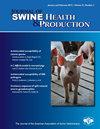猪繁殖和呼吸综合征病毒2型攻击模型中的病毒载量、肺部病变和平均日增重
IF 0.7
4区 农林科学
Q3 Agricultural and Biological Sciences
引用次数: 0
摘要
目的:在接种PRRSV-2谱系8修饰活病毒(MLV)疫苗的猪中,确定猪繁殖和呼吸综合征病毒2(PRRSV-2)谱系1(开放阅读框5限制性片段长度多态性1-7-4[ORF5-RFLP 1-7-4])攻击后的病毒血症、肺损伤百分比、平均日增重(ADG)及其相关性,PRRSV-2谱系1 MLV疫苗或未接种。材料和方法:猪接种Fostera PRRS(n=52)、Prevacent PRRS(n=50)或无菌水(未接种;n=47)。接种疫苗四周后,用PRRSV-2谱系1 ORF5 RFLP 1-7-4攻击所有动物。在激发后3、6和12天测定病毒血症。在整个实验过程中,记录体重以确定ADG。在第40天(激发后12天)评估肺部病变的百分比。结果:与未接种疫苗的猪相比,接种任何一种疫苗都可以减少(P<.001)肺部病变,增加(P<0.001)攻击后的ADG,并更好地控制病毒血症(P<001)。含义:市售的PRRSV-2谱系8疫苗与PRRSV-2血统1疫苗一样有效,可以对抗异源PRRSV-2家谱1病毒攻击。本文章由计算机程序翻译,如有差异,请以英文原文为准。
Viral load, lung lesions, and average daily gain in a porcine reproductive and respiratory syndrome virus-2 challenge model
Objective: To determine viremia, percentage lung lesions, average daily gain (ADG), and their associations after a porcine reproductive and respiratory syndrome virus-2 (PRRSV-2) lineage 1 (open reading frame 5 restriction fragment length polymorphism 1-7-4 [ORF5 RFLP 1-7-4]) challenge in pigs vaccinated with either a PRRSV-2 lineage 8 modified live virus (MLV) vaccine, a PRRSV-2 lineage 1 MLV vaccine, or not vaccinated. Materials and methods: Pigs were vaccinated with either Fostera PRRS (n = 52), Prevacent PRRS (n = 50), or sterile water (nonvaccinated; n = 47). Four weeks after vaccination, all animals were challenged with PRRSV-2 lineage 1 ORF5 RFLP 1-7-4. Viremia was determined at 3-, 6-, and 12-days post challenge. Body weights were recorded to determine ADG throughout the experiment. Percentage lung lesions were assessed on day 40 (12 days post challenge). Results: Vaccination with either vaccine reduced (P < .001) lung lesions, increased (P < .001) ADG post challenge, and better controlled viremia (P < .001) compared to nonvaccinated pigs. Implication: A commercially available PRRSV-2 lineage 8 vaccine was as effective as a PRRSV-2 lineage 1 vaccine against a heterologous PRRSV-2 lineage 1 viral challenge.
求助全文
通过发布文献求助,成功后即可免费获取论文全文。
去求助
来源期刊
CiteScore
1.80
自引率
0.00%
发文量
29
审稿时长
>36 weeks
期刊介绍:
The Journal of Swine Health & Production (JSHAP) is an open-access and peer-reviewed journal published by the American Association of Swine Veterinarians (AASV) since 1993. The aim of the journal is the timely publication of peer-reviewed papers with a scope that encompasses the many domains of applied swine health and production, including the diagnosis, treatment, management, prevention and eradication of swine diseases, welfare & behavior, nutrition, public health, epidemiology, food safety, biosecurity, pharmaceuticals, antimicrobial use and resistance, reproduction, growth, systems flow, economics, and facility design. The journal provides a platform for researchers, veterinary practitioners, academics, and students to share their work with an international audience. The journal publishes information that contains an applied and practical focus and presents scientific information that is accessible to the busy veterinary practitioner as well as to the research and academic community. Hence, manuscripts with an applied focus are considered for publication, and the journal publishes original research, brief communications, case reports/series, literature reviews, commentaries, diagnostic notes, production tools, and practice tips. All manuscripts submitted to the Journal of Swine Health & Production are peer-reviewed.

 求助内容:
求助内容: 应助结果提醒方式:
应助结果提醒方式:


